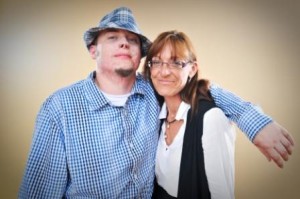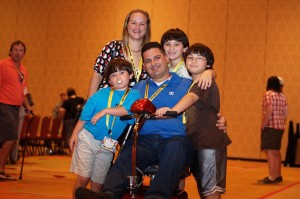
Retired CW3 James Hume talks about life with PTSD.
Emily Oehler, WTC Stratcom
This morning, I had the honor of listening to three people tell their personal story. While each story was unique, heartfelt and powerful—they all showed the full impact of a life with a severe injury, and the impact on the Family. I was in awe as retired Chief Warrant Officer James Hume, Army spouse Gina Hill and retired Sergeant Scott Stephenson shared their stories at the Army Wounded Warrior Program’s (AW2) Symposium.
As I watched James speak, he looked like corporate America—dark suit, clean cut, distinguished. Actually, he looked a lot like actor Bill Pullman who played the president in Will Smith’s Independence Day. Watching him, it was hard to connect what he was saying to his calm, poised demeanor. James suffers from PTSD and mild TBI. Although he received treatment at the combat stress unit in Balad, Iraq, cognitive behavior training at Walter Reed, and coping skills therapy through the Veterans Administration, it wasn’t until he returned home that it all really hit him.
“I returned home, my Family and I were hit hard with the symptoms of PTSD. My condition got worse in my new environment and over the following six months my situation deteriorated to a crisis mode. As a result, I was admitted to the Dallas VA for two weeks to stabilize my condition with medications. About three months later, I was admitted to a seven week inpatient PTSD program at the Waco, Texas VA. It was there, for once, I finally received what I call a well rounded education on PTSD. I was able to process my traumas, recognize triggers, and attempt to alter my behavior. This awareness does not cure PTSD but is intended to improve the quality of life for the Veteran and that also translates to the Family. My wife Diana and I feel awareness, education, and treatment should be extended to the Family members for they are an integral part of the Family dynamics and in many cases Family is all you have left.”
A Marine and Army reservist for nearly 30 years, James served in the Persian Gulf War and volunteered to deploy to Iraq with an ordinance unit. In Iraq he went on missions for route clearance and foot patrols throughout the villages which exposed him to multiple IEDs, mortar and rocket fire and resulted in life-altering injuries.
“This is not the person I use to be. I even avoid people that knew me before so they do not know me now. I try to protect a reputation that is now masked behind incompetence. As a reserve Soldier, this impacted not only my military career but also my civilian career and almost cost me my Family. I have worked hard with coping mechanisms but they also have limits. I can’t respectfully articulate what it is like to live with PTSD. The closest I can come is to imagine your mind is no longer your mind, your life is no longer your life, your dreams are no longer your dreams, you’re not the husband your wife deserves, you’re not the father your children deserve, you’re not the friend your friends deserve, you’re not a contributor to society but rather you view yourself as a burden. To simplify, imagine a life with a broken spirit. This may seem extreme to a normal person but it is normal for a person with PTSD.”
SGT Allen Hill’s wife Gina added that, “While the majority of Allen’s physical, or visible, wounds have healed, our Family still struggles daily with the psychological wounds. Often times, these are called the invisible wounds, but I have a hard time calling them that, for they are very visible to anyone who spends any amount of time with him.”
Gina then spoke about the impact of her husband’s TBI and PTSD on their Family. “These psychological wounds greatly affect not only the Soldier, but the entire Family. My husband’s triggers are now triggers for myself as well as our children. In the rare times we are away from my husband, we are constantly on high alert for his triggers. It is next to impossible for us to turn that off. Our kids have had to become caregiver’s for their dad instead of just being kids. They are well rehearsed in PTSD, calling 911, and explaining why their dad has a service dog, why he isn’t at many of their events, and why he sometimes acts really weird. They also have to understand that plans are never set in stone and are always contingent on their dad’s current mental state.”
She added that, “The struggles I face specifically as a spouse of a warrior suffering with PTSD are many as well. It is difficult watching the person you love fighting to get back to the person they were before war because they do remember what they used to be like, they just can’t figure out how to get back to that person. We have worked very hard to focus on the best he can be now, not who he was. Every part of him is different and when I say every, I mean every. With that being said, it is extremely difficult being married to someone who is completely different than when you married him. There are times that I see glimpses of the man I married, but they are few and far between.”
Her husband commented, “I wish I could get back to the old me for my Family’s sake, my wife’s sake. I know they long for the person I used to be.”
The life-long challenges retired SGT Scott Stephenson talked about were more physical. As a SAW gunner, he experienced third and fourth degree burns over 66 percent of his body and the amputation of his left foot as a result of an IED explosion. “I was sent to Brooke Army Medical Center in San Antonio where I received the best possible care and treatment. My treatment has been a long, hard road, and is still ongoing. Trying to describe living with burns is tough, and the best explanation I can come up with is, it’s like living with most of your body wrapped in air-tight saran wrap. I can’t feel the breeze on my skin.”
With all their challenges, each Family continues to serve and give back through nonprofits they’ve started, those they volunteer with, and through the stories they share so that other wounded Soldiers, Veterans, and Families know they are not alone.







